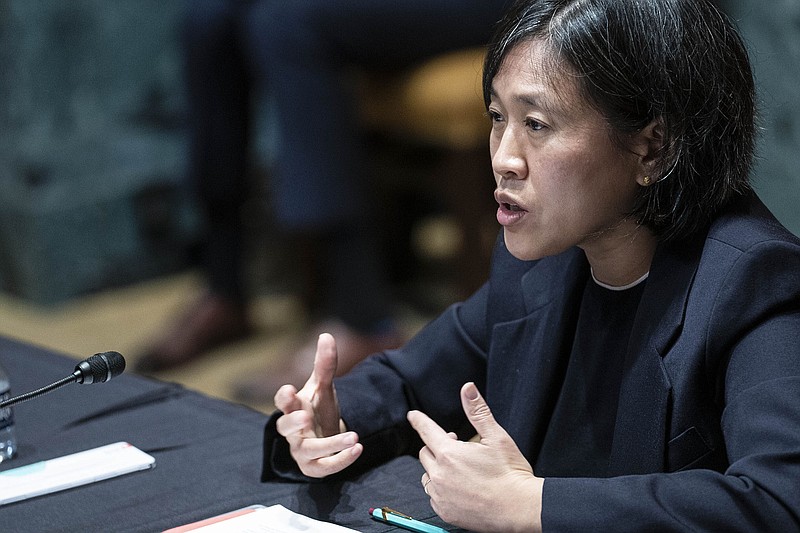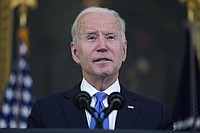WASHINGTON -- Coronavirus infections could be driven to low levels and the pandemic at least temporarily throttled in the United States by July if the vast majority of people get vaccinated and continue with precautions against viral transmission, according to a report released Wednesday by the Centers for Disease Control and Prevention.
The report was issued as administration officials and leaders in many states are sounding more confident that the country can return to a degree of normalcy relatively soon. President Joe Biden on Tuesday announced a new vaccination goal, saying he wants 70% of adults to have had at least one dose by July 4.
CDC Director Rochelle Walensky said Wednesday that the modeling results give Americans a road map out of the pandemic -- so long as they continue to get vaccinated and maintain mitigation strategies until a "critical mass of people" get the shots.
"The results remind us that we have the path out of this, and models, once projecting really grim news, now offer reasons to be quite hopeful for what the summer may bring," she said.
[CORONAVIRUS: Click here for our complete coverage » arkansasonline.com/coronavirus]
The CDC report is not a prediction or forecast. It is a set of four scenarios based on modeling of the pandemic, using different assumptions about vaccination rates, vaccine efficacy and precautions against transmission.
Each scenario shows an epidemic curve in which the national increase in cases that began in early March hits a peak and plummets in late spring, leading to a significantly improved viral landscape this summer. In the less optimistic scenarios, hospitalization numbers will vary significantly from state to state.
Under the most optimistic scenario, deaths linked to covid-19, the disease caused by the novel coronavirus, could drop into the low 100s per week in August and into the "tens" per week in September, according to Justin Lessler, an epidemiologist at the Johns Hopkins Bloomberg School of Public Health and one of the paper's senior authors. More than 4,000 people a week are dying of the disease, and about 578,000 people in the United States have died of covid-19 since the start of the pandemic.
That model includes an assumption that 90% of those eligible for vaccine would get a shot, which Lessler acknowledged "may be on the optimistic side given rates of vaccine refusal in some areas."
[Video not showing up above? Click here to watch » https://www.youtube.com/watch?v=Pnrmpt3tVVg]
Infectious-disease experts caution that the number of new infections remains high. Variants of the virus could emerge with mutations that allow the pathogen to evade vaccines. Immunization hesitancy among large chunks of the population is another concern. High rates of vaccination seen in early April have come down in the past several weeks.
And the long-term picture remains cloudy because of all the unknowns about this virus, which continues to circulate freely around the planet and is driving catastrophic outbreaks in Brazil, Colombia, India and other countries. Some epidemiologists say that even if the coronavirus is suppressed to low levels this summer in the United States, it will rebound in the fall.
There are limitations to the modeling. Although the researchers factored in the highly transmissible coronavirus variant B.1.1.7 now dominant in the United States, it did not contemplate what would happen if an even more problematic variant -- for example, one that could evade vaccine-induced immunity -- were to spread.
The models used data through March 27. The report did not capture the high rate of vaccinations in April, when more than 90 million doses went into arms, according to Washington Post vaccine tracking data. Instead, the report considered 60 million to be a high vaccination rate in April. The high rate of vaccinations so far has made the most optimistic scenario more likely, Lessler noted.
Infection numbers have been dropping nationally since mid-April, and hospitalizations and deaths are also coming down, although more slowly. With more than half of U.S. adults having received at least one dose of vaccine, and with millions more having recovered from an infection, immunity to the coronavirus is increasingly widespread and impeding spread of the virus.
Working against that: the relaxation of public precautions and the rapid increase in social interactions as people emerge from relative isolation and resume, to some degree, their pre-pandemic lives. This is happening even as the virus is causing close to 50,000 new infections a day.
The new models show "a potentially bumpy path between now and the early to midsummer," Lessler said. But he added that all six of the modeling teams that contributed to the CDC report envision a summer in which case numbers are low and outbreaks under control.
TECHNOLOGY WAIVERS
Additionally, the Biden administration on Wednesday joined calls for more distribution of the technology behind covid-19 vaccines to help speed the end of the pandemic, a shift that puts the U.S. alongside many in the developing world who want rich countries to do more to get doses to the needy.
[Gallery not loading above? Click here for more photos » arkansasonline.com/56biden/]
Katherine Tai, the U.S. trade representative, announced the government's position, amid World Trade Organization talks about a possible temporary waiver of its protections that would allow more manufacturers to produce the lifesaving vaccines.
"The Administration believes strongly in intellectual property protections, but in service of ending this pandemic, supports the waiver of those protections for covid-19 vaccines," Tai said in a statement.
She cautioned that it would take time to reach the required global "consensus" to waive the protections under WTO rules, and U.S. officials said it would not have an immediate effect on the global supply of covid-19 shots.
"This is a global health crisis, and the extraordinary circumstances of the covid-19 pandemic call for extraordinary measures," said Tai. "The Administration's aim is to get as many safe and effective vaccines to as many people as fast as possible."
Tai's announcement came hours after WTO Director-General Ngozi Okonjo-Iweala spoke at a closed meeting of ambassadors from developing and developed countries that have been wrangling over the issue, but agree on the need for wider access to covid-19 treatments.
The WTO's General Council took up the issue of a temporary waiver for intellectual-property protections on covid-19 vaccines and other tools, which South Africa and India first proposed in October. The idea has gained support among some progressive lawmakers in the West.
More than 100 countries have come out in support of the proposal, and 110 members of Congress -- all fellow Democrats of Biden -- sent him a letter last month that called on him to support the waiver.
Opponents -- especially from industry -- say a waiver would be no panacea. They insist that production of coronavirus vaccines is complex and can't be ramped up by easing intellectual property. They also say lifting protections could hurt future innovation.
"In the midst of a deadly pandemic, the Biden Administration has taken an unprecedented step that will undermine our global response to the pandemic and compromise safety," said Stephen Ubl, president and CEO of the Pharmaceutical Research and Manufacturers of America.
"This decision will sow confusion between public and private partners, further weaken already strained supply chains and foster the proliferation of counterfeit vaccines," he said.
It remained unclear how some countries in Europe, which have influential pharmaceutical industries and had previously shared U.S. reservations about the waiver, would respond.
WTO spokesman Keith Rockwell said a panel on intellectual property at the trade body was expected to take up the waiver proposal again at a "tentative" meeting later this month, before a formal meeting June 8-9. That means any final deal could be weeks away at best.
He pointed to a change in tone in WTO talks Wednesday, after months of wrangling.
"I would say that the discussion was far more constructive, pragmatic. It was less emotive and less finger pointing than it had been in the past," Rockwell said, citing a surge in cases in places like India.
CHILD VACCINES
Meanwhile, Canadian health officials said Wednesday that they have become the first to approve Pfizer's covid-19 vaccine for children as young as 12.
Dr. Supriya Sharma, chief medical adviser at Health Canada, confirmed the decision for ages 12 to 15 and said it will help children return to a normal life. Canada is the first country to authorize Pfizer for that age group. The U.S. and the European Union are also reviewing it.
The vaccine was previously authorized for anyone 16 or older.
The U.S. Food and Drug Administration is also expected to authorize Pfizer's vaccine for young people by next week, setting up shots for many before the beginning of the next school year. The announcement comes barely a month after the company found that its shot, which is already authorized for those age 16 and older, also provided protection for the younger group.
Pfizer in late March released preliminary results from a vaccine study of 2,260 U.S. volunteers ages 12 to 15 showing there were no cases of covid-19 among fully vaccinated adolescents compared with 18 among those given dummy shots.
Sharma said the evidence is there that the vaccine is safe and effective in that age group. It is the first vaccine approved for children in Canada.
Sharma said about one-fifth of all cases of covid-19 in Canada have occurred in children and teenagers, and having a vaccine for them is a critical part of Canada's plan.
She said while most children don't experience serious illness from covid-19, a vaccine also helps protect their friends and family who may be at higher risk of complications.
"It will also support the return to a more normal life for our children, who have had such a hard time over the past year, she said.
"Today's expansion of our authorization represents a significant step forward in helping the Canadian government broaden its vaccination program and begin to help protect adolescents before the start of the next school year," Fabien Paquette, vaccines lead for Pfizer Canada, said in a statement.
Information for this article was contributed by Joel Achenbach, Lena H. Sun, Dan Keating and Isaac Stanley-Becker of The Washington Post; and by Jamey Keaten, Zeke Miller, Jonathan Lemire and Rob Gillies of The Associated Press.


